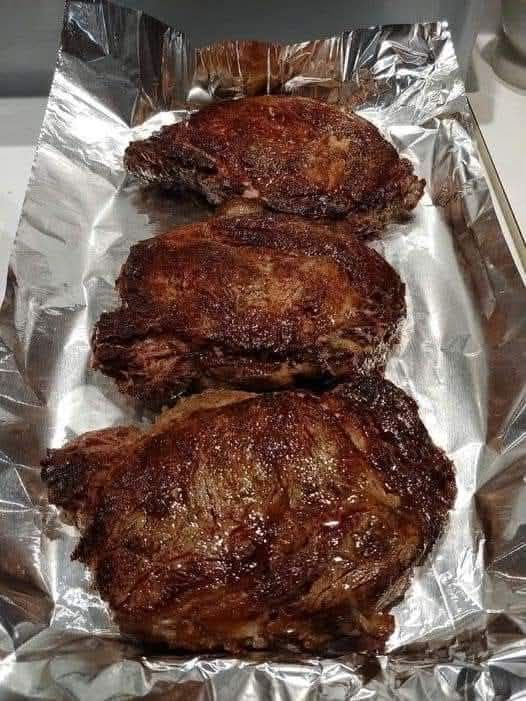ADVERTISEMENT
Instructions
1. Bring to Room Temperature
Before cooking, let your ribeye steak sit at room temperature for 30-45 minutes. This ensures even cooking and prevents the steak from being cold in the center.
2. Season Generously
Pat the steaks dry with a paper towel. Drizzle both sides with olive oil, then generously season with kosher salt and freshly ground black pepper. This simple seasoning enhances the natural flavor of the ribeye.
3. Heat Your Pan or Grill
- For stovetop cooking: Use a cast-iron skillet for the best sear. Heat it over high heat until it’s smoking hot.
- For grilling: Preheat your grill to high heat (450°F to 500°F).
4. Sear the Steak
- Stovetop: Add a small amount of oil to the hot skillet. Place the steaks in the pan and sear for 2-3 minutes on each side, without moving them. This creates a flavorful crust.
- Grill: Place the steaks directly over high heat and sear for 3-4 minutes per side.
5. Add Flavor (Optional)
During the last minute of searing, add butter, garlic cloves, and fresh thyme or rosemary to the skillet. Spoon the melted butter over the steaks for added richness and flavor.
6. Check Doneness
Use a meat thermometer to ensure the steak reaches your desired level of doneness:
- Rare: 125°F (cool red center)
- Medium Rare: 135°F (warm red center)
- Medium: 145°F (warm pink center)
- Medium Well: 155°F (slightly pink center)
- Well Done: 160°F (little to no pink)
7. Rest the Steak
Remove the steak from the heat and let it rest on a cutting board for 5-10 minutes. This allows the juices to redistribute, keeping the steak moist and flavorful.
8. Slice and Serve
Slice the steak against the grain for maximum tenderness. Serve with your favorite sides, such as garlic mashed potatoes, roasted vegetables, or a crisp green salad.
Tips for the Perfect Ribeye Steak
- Don’t overcook: Ribeye is best enjoyed at medium-rare or medium to preserve its juicy texture.
- Use high heat: High heat is essential for a proper sear and flavorful crust.
- Rest your steak: Skipping this step can result in a dry steak as the juices escape when you cut into it.
- Experiment with flavors: While salt and pepper are classic, you can add spice rubs or marinades for variety.
Pairing Ribeye Steak
Ribeye pairs beautifully with robust red wines like Cabernet Sauvignon or Malbec. For beer lovers, a dark stout or a malty amber ale complements the richness of the steak.
With this recipe and guide, you’re ready to cook a ribeye steak that rivals any steakhouse. Whether it’s a special occasion or just a regular weeknight treat, this tender, flavorful steak will impress every time.
ADVERTISEMENT
ADVERTISEMENT
